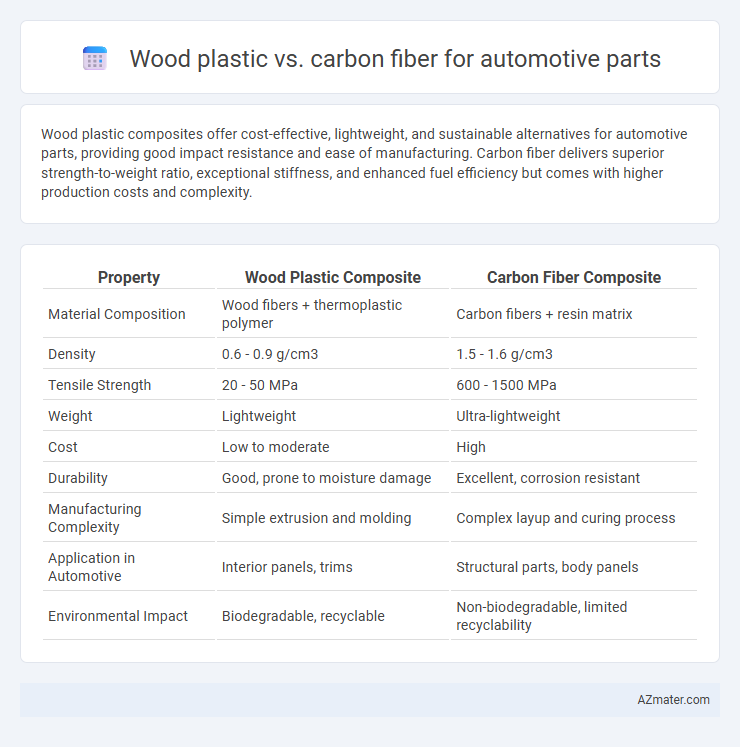Wood plastic composites offer cost-effective, lightweight, and sustainable alternatives for automotive parts, providing good impact resistance and ease of manufacturing. Carbon fiber delivers superior strength-to-weight ratio, exceptional stiffness, and enhanced fuel efficiency but comes with higher production costs and complexity.
Table of Comparison
| Property | Wood Plastic Composite | Carbon Fiber Composite |
|---|---|---|
| Material Composition | Wood fibers + thermoplastic polymer | Carbon fibers + resin matrix |
| Density | 0.6 - 0.9 g/cm3 | 1.5 - 1.6 g/cm3 |
| Tensile Strength | 20 - 50 MPa | 600 - 1500 MPa |
| Weight | Lightweight | Ultra-lightweight |
| Cost | Low to moderate | High |
| Durability | Good, prone to moisture damage | Excellent, corrosion resistant |
| Manufacturing Complexity | Simple extrusion and molding | Complex layup and curing process |
| Application in Automotive | Interior panels, trims | Structural parts, body panels |
| Environmental Impact | Biodegradable, recyclable | Non-biodegradable, limited recyclability |
Introduction to Composite Materials in Automotive Applications
Wood plastic composites (WPCs) and carbon fiber reinforced polymers (CFRPs) represent two significant categories of composite materials used in automotive applications to enhance performance and sustainability. WPCs combine natural wood fibers with thermoplastics, offering cost-effective, lightweight, and environmentally friendly alternatives suited for interior components and non-structural parts. CFRPs deliver superior strength-to-weight ratios, stiffness, and durability, making them ideal for high-performance structural elements and weight reduction in vehicles, ultimately improving fuel efficiency and safety standards.
Overview of Wood Plastic Composites for Automotive Parts
Wood plastic composites (WPCs) for automotive parts combine natural wood fibers with thermoplastic polymers, offering enhanced durability, lightweight properties, and sustainability compared to traditional materials. These composites provide excellent resistance to moisture, corrosion, and impact, making them suitable for interior components, trim, and dashboards. WPCs contribute to reduced vehicle weight and improved fuel efficiency while supporting eco-friendly manufacturing processes through the use of renewable resources.
Key Properties of Carbon Fiber in Vehicle Manufacturing
Carbon fiber exhibits exceptional tensile strength, lightweight characteristics, and high stiffness, making it ideal for enhancing vehicle performance and fuel efficiency in automotive parts. Its superior resistance to corrosion and fatigue extends the lifespan of components under dynamic driving conditions. Compared to wood plastic composites, carbon fiber offers significantly higher strength-to-weight ratios, enabling the production of safer and more durable automotive structures.
Weight Comparison: Wood Plastic vs Carbon Fiber
Carbon fiber offers a significantly lower weight compared to wood plastic, with densities typically around 1.6 g/cm3 versus wood plastic composites averaging 1.2 to 1.4 g/cm3 but higher overall due to fillers. The superior strength-to-weight ratio of carbon fiber enables automotive parts to achieve enhanced performance and fuel efficiency through substantial weight reduction. Wood plastic composites, while heavier than carbon fiber, provide cost-effective durability but are less optimal for applications requiring minimal weight.
Strength and Durability Analysis
Wood plastic composites offer moderate strength and durability, making them suitable for non-structural automotive parts with resistance to moisture and corrosion. Carbon fiber exhibits superior tensile strength and fatigue resistance, significantly enhancing performance and longevity in high-stress automotive components. Comparative analysis shows carbon fiber outperforms wood plastic in stiffness-to-weight ratio and impact resistance, crucial for safety-critical applications.
Cost-Efficiency and Production Scalability
Wood plastic composites offer cost-efficiency with lower raw material and processing expenses compared to carbon fiber, making them suitable for large-scale automotive parts production. Carbon fiber delivers superior strength-to-weight ratio but involves high material costs and specialized manufacturing processes that limit production scalability. For mass-market automotive parts, wood plastic composites provide a scalable and economical solution, whereas carbon fiber remains ideal for high-performance, low-volume applications.
Environmental Impact and Sustainability
Wood plastic composites (WPCs) offer a more sustainable alternative to carbon fiber in automotive parts due to their renewable biomass content and lower energy consumption during production. Carbon fiber, while providing superior strength-to-weight ratio, involves energy-intensive manufacturing processes and poses challenges in recycling, contributing to higher environmental impact. Incorporating WPCs reduces vehicle weight and emissions without compromising eco-friendly goals, making them preferable for sustainable automotive manufacturing.
Design Flexibility and Aesthetic Considerations
Wood plastic composites offer significant design flexibility with the ability to be molded into complex shapes and incorporate natural wood grain aesthetics, providing a unique and warm appearance ideal for interior automotive parts. Carbon fiber excels in sleek, high-performance designs with superior strength-to-weight ratios, delivering a modern, high-tech aesthetic often favored in exterior and structural components. Combining wood plastic for tactile and visual warmth with carbon fiber's futuristic appeal can optimize both aesthetic appeal and functional design in automotive applications.
Performance in Real-World Automotive Scenarios
Carbon fiber outperforms wood plastic composites in real-world automotive scenarios due to its superior strength-to-weight ratio, enhancing vehicle acceleration and fuel efficiency. Wood plastic composites offer benefits like cost-effectiveness and environmental sustainability but lack the high tensile strength and stiffness required for critical structural components. Carbon fiber's resistance to fatigue and corrosion makes it the preferred choice for performance-driven automotive parts demanding durability and lightweight performance.
Future Trends: Advancements in Composite Materials
Future trends in automotive parts highlight significant advancements in wood plastic composites and carbon fiber materials, focusing on enhanced strength-to-weight ratios and sustainability. Innovations in wood plastic composites aim to improve biodegradability and cost-effectiveness, supporting eco-friendly vehicle production. Simultaneously, carbon fiber developments target increased recyclability and integration with smart sensors, promoting high-performance and intelligent automotive components.

Infographic: Wood plastic vs Carbon fiber for Automotive part
 azmater.com
azmater.com